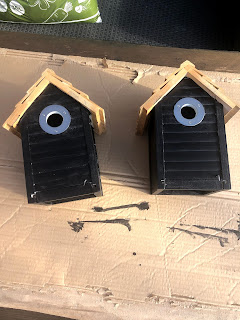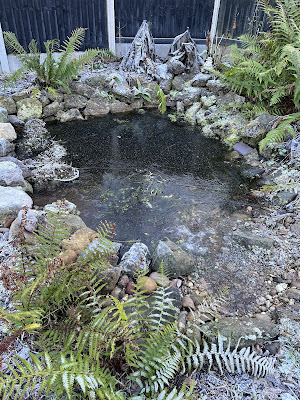Spring border plan
This year we have a relatively large south-facing border to plant, this is quite a new challenge as most of the garden has remained in shade/partial shade up to now. The area measures 6m in length and is backed by fencing. It has a curved outer edge as it follows the route of a gravel path. This curvature provides differing depths of between 1.5 - 2.5m.
Last year the area was a challenge to plant because of the tall trees in the surrounding area blocking out most of the afternoon sun and the soil remaining boggy (heavy clay). However, now that these trees have been removed and we have been improving the soil with bark mulch and homemade leafmould, we are looking forward to having sunshine throughout the day in this spot.
The bed currently houses two dwarf apple trees on the left. There are several Alium bulbs scattered through the border too that I am keen to retain, a Himalayan Birch (Betula Snow queen), Dogwood (Cornus alba 'Sibirica') and Lady's mantel (Achillea mollis).
I have already prepared the planting area by improving drainage with a mixture of horticultural grit and sand, this was absolutely knackering and I was aching for days. This manual labour has prepared the way for the planting of three Euphorbia characias. They have been chosen for structure and height and partnered with ferns that also appreciate sunshine. Dryopteris affinis Cristata and Drypoteris filix mas Crista Cristata should grow to an impressive height too. The ferns pinnae and their bright green colour will compliment the flower heads and structure of the Spurge nicely - well that is the vision at this stage.
Current border:
I am sticking to a few rules (now applied to the whole garden). Ideally I would like:
For the plan to work I have chosen evergreen/semi-evergreen plants for year round structure that do well in full sun or partial sun/shade (Ferns/Euphorbias) .
I am adding flowering perennials of differing heights in groups of three that provide accessible sources of nectar. These trios will be repeated throughout the area. (Patty's Plum poppy, Plume thistle, Snowy woodrush, Campanula Loddon Anna, Scabiosa Pink Mist and a white Yarrow) I have mainly chosen plants with umbels and single inflorescences.
Verbena bonariensis and Coral Reef poppy will drift throughout the spaces that remain, complimented by the upright structure of Erysimum bowles mauve to fill the gaps and finally Geranium Wargrave pink in the foreground.
This is the basic plan. From past experience I am sure that I will not be able to resist the urge of adding more to the border as the year progresses and my various seeds successfully germinate - i'm already eyeing up some Honeysuckle.
Now we just need the unseasonal snow to melt and the soil to warm up :)
I have already prepared the planting area by improving drainage with a mixture of horticultural grit and sand, this was absolutely knackering and I was aching for days. This manual labour has prepared the way for the planting of three Euphorbia characias. They have been chosen for structure and height and partnered with ferns that also appreciate sunshine. Dryopteris affinis Cristata and Drypoteris filix mas Crista Cristata should grow to an impressive height too. The ferns pinnae and their bright green colour will compliment the flower heads and structure of the Spurge nicely - well that is the vision at this stage.
Current border:
 |
 |
 |
I am sticking to a few rules (now applied to the whole garden). Ideally I would like:
- to achieve a woodland/cottage garden feel
- to continue attracting bees, butterflies and birds
- height, structure/drama and colour
- the overall size of each plant and how this relates to spacing
- the type of flower-head
- the hardiness of each plant
- the colour/flowering time of each plant and how this relates to all the other choices
For the plan to work I have chosen evergreen/semi-evergreen plants for year round structure that do well in full sun or partial sun/shade (Ferns/Euphorbias) .
I am adding flowering perennials of differing heights in groups of three that provide accessible sources of nectar. These trios will be repeated throughout the area. (Patty's Plum poppy, Plume thistle, Snowy woodrush, Campanula Loddon Anna, Scabiosa Pink Mist and a white Yarrow) I have mainly chosen plants with umbels and single inflorescences.
Verbena bonariensis and Coral Reef poppy will drift throughout the spaces that remain, complimented by the upright structure of Erysimum bowles mauve to fill the gaps and finally Geranium Wargrave pink in the foreground.
To soften the fences and provide a backdrop I am placing a climber against one of the fence panels. This fence panel is also going to house a butterfly habitat. I am repeating the garden wire and vine-eye technique to give the plant support.
I have painted the Butterfly habitat with a water-based garden paint to prolong its life and that of its inhabitants. I have read somewhere that this colour is one of several which attracts adult butterflies. Coincidently it almost exactly matches the flower colour of the accompanying Chocolate vine (Akebia quinata).
I have painted the Butterfly habitat with a water-based garden paint to prolong its life and that of its inhabitants. I have read somewhere that this colour is one of several which attracts adult butterflies. Coincidently it almost exactly matches the flower colour of the accompanying Chocolate vine (Akebia quinata).
 |
 |
This is the basic plan. From past experience I am sure that I will not be able to resist the urge of adding more to the border as the year progresses and my various seeds successfully germinate - i'm already eyeing up some Honeysuckle.
Now we just need the unseasonal snow to melt and the soil to warm up :)





Comments